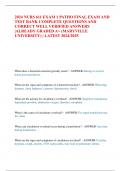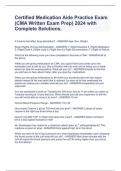2024 NURS 611 EXAM 1 PATHO FINAL EXAM AND
TEST BANK COMPLETE QUESTIONS AND
CORRECT WELL VERIFIED ANSWERS
|ALREADY GRADED A+ (MARYVILLE
UNIVERSITY) | LATEST 2024/2025
When does a bacterial reaction typically onset? - ANSWER-During or several
hours post-transfusion.
What are the signs and symptoms of a bacterial reaction? - ANSWER-Wheezing,
dyspnea, chest tightness, cyanosis, hypotension, shock.
What are the actions for circulatory overload? - ANSWER-Stop/slow transfusion,
dependent position, administer oxygen, diuretics, morphine.
What is the cause of circulatory overload? - ANSWER-Too rapid transfusion rate
for client.
When can circulatory overload occur during a transfusion? - ANSWER-Any time
during transfusion.
What are the signs and symptoms of circulatory overload? - ANSWER-Crackles,
dyspnea, cough, anxiety, JVD, tachycardia, may lead to pulmonary edema.
,What chronic diseases are associated with anemia of inflammation? - ANSWER-
RA, severe infections, many cancers.
What are the risk factors for anemia? - ANSWER-Blood loss, hemolysis, dietary
intake/malabsorption, bone marrow suppression, age.
What are some causes of acute or chronic blood loss? - ANSWER-Trauma, heavy
menstrual flow, gastrointestinal bleed, intra or postsurgical blood loss or
hemorrhage.
What are some causes of increased hemolysis? - ANSWER-Defective Hgb (sickle-
cell disease), impaired glycolysis (G6PD deficiency anemia), immune disorder or
destruction, mechanical trauma to RBCs.
What are some causes of inadequate dietary intake or malabsorption? - ANSWER-
Iron deficiency, vitamin B12 deficiency, folic acid deficiency.
What is pernicious anemia? - ANSWER-Deficiency of intrinsic factor produced by
gastric mucosa, necessary for absorption of vitamin B12.
What is pica? - ANSWER-Persistent eating of nonnutritive substances, such as soil
or chalk, for at least 1 month.
When are platelet transfusions indicated? - ANSWER-< 20K with cancer or severe
thrombocytopenia, symptomatic thrombocytopenia (bleeding)
What are the considerations for platelet transfusions? - ANSWER-Do not infuse
through pump or filter, infuse over 15-30 mins with large needle, must be ABO
compatible, keep at room temp, agitate bag periodically, use Y tubing
, What is fresh frozen plasma? - ANSWER-Plasma transfusion containing clotting
factors
When is fresh frozen plasma indicated? - ANSWER-Multiple factor deficiencies
and actively bleeding, DIC, emergent reversal of warfarin, burn patients,
hemophilia, von Willebrand
What are the considerations for fresh frozen plasma transfusions? - ANSWER-
Frozen within 8 hours of collection but can last a year, infuse over 30-60 minutes,
can use pump, infuse immediately after thawing (< 6hrs), must be ABO compatible
(Rh factor not required)
What are the risks of fresh frozen plasma transfusions? - ANSWER-Acute allergic
reactions common, anaphylactic reaction may occur
What is plasma protein (Albumin)? - ANSWER-Plasma derivative with no risk of
viral transmission
What change in temperature should be reported? - ANSWER-A change of 1-2°F or
more.
Why is it important to report a transfusion reaction? - ANSWER-To assess the
situation carefully.
What is the recommended size for IV access? - ANSWER-At least 20G, preferably
18G.
What supplies are needed for blood product administration? - ANSWER-500 ml
bag of NS, Y-tubing.





